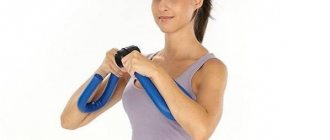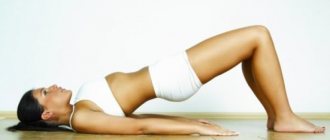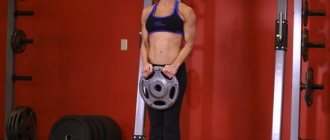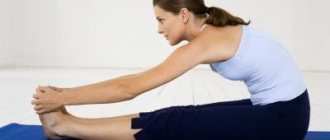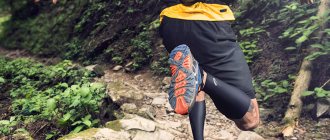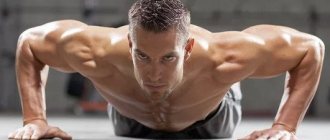Dynamic stretching is a unique combination of stretching and movement. To prepare the muscles for training, swing movements of the arms and legs are used with a gradual increase in amplitude. The essence of dynamic exercises comes down to using the maximum amplitude of muscle movement without going beyond the natural limit.
It is worth listening to the advice of doctors and performing this type of stretching before starting each workout. In this way, the body will be maximally prepared for the upcoming loads. In essence, dynamic stretching is an active motor warm-up with an increased emphasis on muscle stretching.
Full body stretching exercises
By adding these five stretches to the end of your workout, you'll instantly feel more relaxed, mobile, and flexible. Just make sure your muscles are warmed up before passive stretching. A short, dynamic warm-up will suffice.
Each stretch should be held for 30-45 seconds once or twice. Do not stretch until it hurts or perform springy movements. Perform this set of stretching exercises 2-3 times a week. And don't forget to breathe!
Lunges with quadriceps stretch
If you exercise a lot, or sit for long periods of time during the day, then you are almost guaranteed to have tight thigh muscles. This two-in-one stretch will help target both your hip flexors and quadriceps.
Take the starting position: the front leg is bent at a right angle, and the second leg is extended back. Tighten your core and glutes, then slowly lean back and, using your hand to grab your ankle, pull your leg toward your hip as far as you can. In the final position, for the best effect, try to relax. Don't forget to work both sides.
Pigeon stretch
Coming from yoga, this stretch is great for targeting the glutes. It will be a great help no matter your current flexibility level or training goals.
Place one knee in front of you, leaving the other leg extended behind you. Place both hands on the floor in front of you and slowly lower your body as far as you can, keeping your hips and shoulders straight. Here your goal is to lower yourself to your elbows. If you are not yet flexible enough, stay on your palms.
Bridge on the platform
While most people are familiar with the bridge (called wheel pose in yoga) with the hands and feet on the floor, this variation with the feet elevated really allows for greater impact on the shoulders and upper back while specifically stretching the chest. Since most of us have fairly locked shoulder joints, elevated leg bridges are an amazing way to loosen and stretch the upper body without putting undue stress on the lower back.
Lie on your back with your feet on a step platform, plyo box, or other firm, elevated surface. The higher it is, the more the shoulders will stretch, but at the same time, it will be more difficult to get into the bridge. Place your hands on the floor, placing them wider than your shoulders, with your toes pointing towards your feet. Stand on your hands, lifting your hips and squeezing your glutes. Maintain even breathing, smoothly stretching the shoulder joint while keeping your gaze on your fingers.
Jackknife exercise
If you do a lot of plyometric exercises or intense leg workouts, give your hamstrings some TLC. These two variations of the classic "jackknife" will get the job done.
Sit down with your legs extended in front of you. Tighten your quadriceps, pull your stomach in, and lean forward as far as you can. Try gripping the soles of your feet for a deeper stretch.
For more advanced stretches, you can use a wall to take your hip stretch to a whole new level. But first, a warning: if you have a tight hamstring (like most people), it will hurt at first. But it's worth it!
Stand facing a wall with your feet together. Then lean forward, crossing your arms above your head, and rest your upper back against the wall. Slowly slide down the wall while keeping your legs straight. The closer you are to the wall, the deeper the stretch.
Exercise Iron Cross for chest and back stretching
Most people do a lot of back and forth movements in their workouts, but not a lot of twisting. This amazingly effective stretch helps open up your back and chest at the same time while twisting your core. Avoid this movement if you have a history of spinal disc or lower back injuries.
Lie on your stomach with one arm extended to the side. Turn away from this arm in the other direction, but do not damage the shoulder joint. Bend the leg that is on top, lowering your foot to the floor. The more you twist, the better your pectoral and back muscles will open. Breathe evenly while holding the pose. Don't forget the other side.
Isometric stretching
Example of isometric stretching: “pushing the wall”
Isometric stretching is a type of stretching that involves the resistance of muscle groups caused by isometric contractions of the muscles being stretched. Examples of isometric stretching: “pushing the wall” to warm up the calf muscles, bending forward with your foot on a bar counter and trying to reach your head to your knee, and also a biceps stretch by placing your straight arm on the wall and applying force to it.
There is some evidence that isometric stretching exercises performed over a long period of time promote the development of muscle hypertrophy (increase in size). This is due to the fact that this type of stretching involves the resistance of muscle fibers.
The best exercises to stretch your back
Step - tilt. This element of the program allows you to improve the flexibility of the muscles of the back, hamstrings and buttocks. Stand up straight and take a step forward. Then, without rounding your back, bend over and try to touch your front foot.
It's okay if you can't do it right away. Try to get lower and lower towards your goal with each step. Returning to the starting position, repeat the exercise on the other leg. Only 12 - 14 steps.
Lazy stretches. You can do it right at your desk or in front of the TV. Sit on a chair, straighten up and tighten your abdominal muscles. Without rounding your back, lift your right knee toward your chest
Place your hands on your shin and gently pull it towards you
When you feel a sufficient stretch in your lower back, hold for 30 seconds and then repeat the same on your left leg.
Bends while sitting. The deep muscles located along the spine are well stretched. Sit on the floor, legs bent at the knees and widely spaced, back straight.
Take a deep, slow breath and relax your muscles, and as you exhale, bend forward as much as possible with your arms outstretched, trying to lie with your chest on the floor until you feel a sufficient stretch across your entire back. Hold the stretch for 30 seconds while continuing to breathe deeply. Repeat at least 4 – 6 times.
Gymnastic stretches. This static element of the program provides a deep stretch to the upper back muscles.
To perform it, stand close to the doorway and clasp it with your right hand at waist level. Inhale deeply and as you exhale, bending your lower back, tilt your torso down. At the same time, move your buttocks back as far as possible until you feel an optimal stretch on the right side of your back. Hold the position for 30 seconds and then repeat with your left hand.
"Good morning". This movement stretches the lower back and hamstrings.
Stand up straight with your hands clasped behind your head (or on your chest). As you bend at the waist, bend your upper body as low as you can. Always keep your back straight at this moment. Then return to the starting position and repeat another 10 - 12 times.
Active stretching
Swing your legs to the side, a typical element of active stretching
In active stretching, you take a certain position and maintain it only with the help of your own agonist muscles (prime movers). To hold the body in the desired position, agonist muscle groups have to tense, while antagonist muscles begin to stretch. For example, a stance in the position of a side kick, characteristic of martial arts, helps to stretch the adductor muscles, increases the flexibility of the athlete’s body and the height of the leg when striking.
The effect of active stretching is based on a physiological reaction called reciprocal inhibition. If one muscle group is held in a tense position for a long period of time, then the muscle groups opposite it do not need to remain tense, so they relax and stretch. Most often, the position must be held for no longer than 30 seconds, and sometimes results can be achieved in less than 10–15 seconds.
Active stretching is widely used in yoga classes. Martial artists and ballet dancers also use it heavily. Active stretching techniques improve performance in most sports.
Stretching dynamic stretching
22.02.2016
Neglecting to stretch after workouts? And in vain: it prevents injuries and extends the “lifespan” of our joints and ligaments.
There are four types of stretching - static, proprioceptive, ballistic and dynamic. Our fitness complex is based on dynamic stretching. It involves smooth movements that end with a short fixation of the body at the end point of the amplitude. Thanks to this, dynamic stretching does not take as much time as static stretching, with long-term fixation of the final pose. And the absence of sudden movements (as in ballistic stretching) makes it safe for people with problem joints. Moreover, dynamic stretching improves athletic performance and reduces the risk of injury during exercise. In addition, it helps relieve back tension after a working day. Perform our complex before a run, as a cool-down after a workout, or at home after work - and you will become more flexible in just 3 weeks!
Training plan
Exercise twice a week, doing all the exercises in order. Repeat the complex, performing exercises 2-6 on the other side.
Plie with floor touches
The muscles of the arms, back, shoulders, and inner thighs work.
Stand straight, feet wider than shoulder width, toes pointed out, arms raised up. Lower yourself into a plie, arms down, elbows touching knees. Raise your right arm, then lower and raise your left arm. Return to the starting position. Perform 8 repetitions.
Deep Lunge
The muscles of the buttocks and back work.
Lunge forward with your left leg. The left thigh should be parallel to the floor. Place your hands on the floor on either side of your left foot. Pull your left shoulder back and raise your left arm. Return to the starting position and proceed to the next exercise.
Pigeon
The hip flexors, buttocks and abdominal muscles work.
Place your left knee on the floor next to your right hand, with your left foot on the floor under your right thigh. Lower your right thigh as low as possible to the floor (try to lay it on the floor), lower your shoulders and tuck your head and chest, keeping your back straight. Fix this pose and then proceed to the next exercise.
Downward facing dog
The muscles of the back, legs and shoulders work.
Raise your hips so that your body resembles an inverted V. Raise your left leg until it forms a straight line with your arms. Next, pull your left knee toward your chest and lower into a lunge. Perform 8 repetitions of the entire movement sequence (exercises 2 to 4).
Stretch turns
The muscles of the neck and shoulders work.
Stand straight with your feet shoulder-width apart. Place your right hand behind your back and lower it with your palm facing away from you. Place your palms behind your back. Squeeze your shoulder blades and bend your left elbow to stretch your right shoulder. While holding the stretch, tilt your head toward your left shoulder to complete the repetition. Perform 8 repetitions.
Bend overs with arm raises
The muscles of the shoulders, legs, chest and back work.
Stand straight, legs wide apart, toe of your left foot turned to the side. Turn your body to the left. Join your hands behind your back in a lock. Lean forward and raise your arms at the same time. Return to the starting position. Perform 8 repetitions.
The article was taken from the site bodymaster.ru.
Stretching - women
Passive stretching
An example of passive stretching - the well-known split
Passive stretching is a form of stretching ideal for doing with a partner. In this case, it is necessary that the body remains completely passive, and all actions are performed with the application of external force (with the help of a partner). If training is carried out without a partner, body weight and gravity are used as an external force. For this reason, passive stretching is also called relaxed stretching.
An example of passive stretching is the well-known split. By spreading your legs as wide as possible and releasing your body weight on them, you allow your feet to naturally slowly slide further to the sides. Research has shown that passive stretching is ideal for muscle recovery from injury because it is done gradually and requires some time for each position.
Stretching or stretching and flexibility exercises for beginners
Of course, the process of stretching does not actively promote weight loss, but it actually helps prepare your body for those strenuous forms of exercise (aerobic, strength or plyometric) that will allow you to quickly lose excess weight, as well as improve your range of motion and protect your joints and muscles from possible injuries.
What are the benefits of stretching for beginners?
Improves blood flow. Performing a set of stretching exercises encourages improved blood supply to all tissues of your body, including the brain. Morning exercises will help you get an extraordinary boost of energy, a high level of concentration, and also prevent fatigue and lethargy after a night's sleep. A good stretching program will involve all your vital organs, including your heart, in active work, relieving it of excess internal tension throughout the day.
Increases flexibility. Another benefit of stretching is that it significantly improves the flexibility of your entire body by increasing the range of motion of your major joints (hip, shoulder, ankle, etc.). This moment will allow you to move more freely and efficiently.
Supports a sense of balance. Lack of flexibility in one or more muscle groups can lead to muscle imbalances and, as a result, poor posture. Tight muscles negatively impact the joints, slowly creating a shift from their normal alignment. Connective tissue gradually shortens to adapt to these conditions. All this leads to a situation where the body begins to lose the ability to function at full capacity, which causes frequent injuries.
Relieves stress. Static stretching can be relaxing, both physically and mentally. Using deep and slow breathing during exercise effectively reduces the feeling of stress, one of the side effects of which is an increase in muscle tension.
Relaxes muscles. Morning stretching exercises will help make your muscles more elastic, which leads to their overall relaxation. And this is a huge plus! After all, tension in the muscles can lead to the development of discomfort, spasms and pain. And stretching allows muscle fibers to warm up and relax, which significantly reduces the risk of injury during strength training.
Prepares you for training. If you have another visit to the gym planned for today, start preparing your body from the moment you wake up. Stretching in the morning will prime your body for physical activity and help prevent muscle damage. And they, according to researchers, can greatly improve the overall level of your athletic performance.
Helps during the rehabilitation period. If you have suffered an unpleasant injury during strength training, then regular stretching sessions will help speed up your healing.
But, do not forget that this process must be gradual! That's why it's so important not to overdo it, otherwise you can cause even more harm.
Increases bone mineralization. In addition to making you physically stronger, proper stretching has additional benefits for your skeletal system. Due to the increased load on the bones, it significantly increases their mineral density, which helps prevent the development of osteoporosis and various fractures.
Promotes weight loss! And finally, stretching accelerates muscle growth and improves body composition by reducing the percentage of fat tissue
This is very important, since the opposite process occurs in the body over time, and muscle cells, as we know, due to their metabolic activity, require more energy throughout the day.
Benefits of Stretching
- Reduced muscle tension
- Expanding range of motion in joints
- helps avoid injury
- increases muscle strength
- Improved coordination of movements
- Acceleration of blood circulation in various parts of the body
- Improving the body's energy production processes
- Increasing muscle fatigue threshold and increasing endurance
- Increased efficiency in daily activities, as well as in sports and other physical activities
- Posture correction
- Mental relaxation
- Finally pleasure, a feeling of lightness throughout the body.
How to stretch correctly
Before you rush headlong into the pool, remember the rules for stretching that will keep your muscles and joints healthy:
- Warm up your body before starting stretching exercises. “Cold” joints and muscles stretch poorly, and therefore it is very easy to get injured in the form of a sprain or tear. To “warm up”, you can choose any of the aerobic activities: running, jumping rope, exercise bike or orbitrek. If you are doing anaerobic (strength) exercises, stretch at the end of the session, as it helps to relax the muscles, and you will get worse results when lifting weights if you stretch before starting the exercises.
- Perform stretching exercises smoothly, without sudden movements and with a small amplitude (ideal - static stretching).
- Do not tense your muscles while stretching. Relaxed, they will stretch much easier.
- Don't slouch while doing stretching exercises. A slouched back, bent knees, and tense muscles make stretching ineffective.
- Breathe calmly and don't hold your breath. In the starting position, inhale through your nose, and at the moment of stretching, exhale through your mouth. If you are doing static exercises, breathe deeply on each count.
- Perform each stretch for 30-60 seconds. The stretching time depends on the flexibility of your joints and muscles, so if you find it difficult to hold your body for 1 minute, start with the maximum time possible (10-20 seconds) and gradually increase it, bringing it to the required 60 seconds.
- Do stretching exercises regularly. Starting three times a week and depending on how you feel, increase the duration and frequency of your workouts. Ideally, you should do stretching for 30-50 minutes daily (except for professional dancers, who spend 1.5-2 hours stretching per workout).
- Avoid severe pain. Stretching is a traumatic process and therefore it is better to listen to the body’s signals. If during stretching your muscles hurt a little, but you feel that it has an effect, they stretch and do not cause severe discomfort - everything is normal. If, during stretching, something crunches, rings in your ears, or begins to feel nauseous due to severe pain, immediately finish the exercise and from now on be guided by your own sensations.
- Stretch your body symmetrically. After spending 5 minutes on the right quadriceps, leave the same amount of time on the left front thigh. Only if you stretch symmetrically can you achieve benefits for your body.
Spinal stretch at home
The same system is used for stretching the spine as for stretching the legs. But to start intensive exercises for the spine, make sure that you have no contraindications, which include:
- the presence of inflammatory processes in the body;
- heart disease or defects;
- blood pressure problems, blood clots;
- diseases of bone and joint tissue, hernias.
All exercises involving bending forward, backward and to the sides are suitable as stretching exercises for the spine. Properly performed stretching does not injure the spine, but this requires an individual approach.
Stretching in the pool
How to Improve Abdominal Stretching
"Awakening". This exercise helps to stretch not only the anterior and oblique abdominal muscles, but also the deep muscles that run along the spine.
Stand straight with your feet shoulder-width apart. Interlace your fingers and extend your arms above your head, palms facing the ceiling. Inhale and squeeze your glutes and abdominals while stretching your arms upward. Exhale and lean to the right, keeping your hips engaged. Hold for 20 – 30 seconds and return to the starting position. Reach towards the ceiling again and tilt in the other direction.
Bow pose. An excellent exercise for stretching the abdominal and chest muscles, it gets its name because your body will resemble the shape of a bow when you do it.
Lie on your stomach and bend your knees. Then, bending your spine well, grab your ankles with your hands. To increase tension in muscle fibers, lift your legs as high as possible towards the ceiling and draw your heels closer to your buttocks. With the ideal technique for performing the pose, you will touch the surface of the floor only in the abdominal area.
Soft bridge. To complete the element you will need a fitball. Sit on the ball with your knees bent and your feet slightly turned outward for a greater sense of balance. Leaning back, begin to move your feet forward until the ball, rolling under you, stops in the middle of your back.
Raise your arms up, arch your torso and try to reach the floor with your palms. At this moment, you will feel the chest and abdominal muscles (obliques, transverse and rectus muscles) stretching.
Cobra twist. It is especially effective for the internal and external oblique muscles of your waist and is similar to cobra pose. To perform, lie on your stomach with your legs straight. Press your palms into the floor, as if you were doing push-ups, and then, pushing with your hands, lift your upper body and arch your spine well.
Bend your right arm and rotate your torso to the left. You should feel how well the muscles on the left side of your abdomen stretch. Pause for a while at the point of maximum resistance and repeat the movement in the other direction.
Rotations on a chair. The exercise perfectly stretches the muscles of the abdomen and lower back, which are involved in turning the body to the right and left.
Sit on the front edge of a chair with your feet flat on the floor. Turn your torso as far as possible to the left and grab the back of the chair with both hands. Additionally, tighten your core muscles, hold for 5 – 10 seconds and return to the starting position. With the next turn, try to take an even greater range of motion. Only 3 – 5 times, then similarly in the other direction. Published by econet.ru.
https://youtube.com/watch?v=c1ZIhtEEtjc
PS And remember, just by changing your consciousness, we are changing the world together! econet
Ballistic stretching
Ballistic stretching is a type of stretching that uses jumping and sudden movements. This form of stretching is strongly discouraged by the American Academy of Orthopedic Surgeons and is considered one of the most common causes of stretching injuries.
Ballistic stretching exercises should not be attempted without an adequate warm-up, as they push your body beyond its comfort zone. Using ballistic stretching as a warm-up is unacceptable. Ballistic stretching, after a good warm-up, is widely used by martial artists, ballet dancers and gymnasts to expand a comfortable range of motion and increase body flexibility.
Research on ballistic exercises shows that when performed after a core workout or as a stand-alone routine, they help increase range of motion and improve performance. Martial artists, gymnasts and dancers know this very well.
Isometric stretching
Isometric stretching is a type of static stretching (that is, without movement) that uses counteracting the isometric contraction of the target muscle group, that is, resisting the tension of the muscle we want to stretch.
Using isometric stretching is one of the fastest ways to develop static-passive plasticity; the method is much more effective than passive stretching or active stretching alone. In addition, isometric stretching develops the strength of “tight” muscles (which helps sharpen static-active flexibility) and somewhat reduces the degree of pain that many are accustomed to associate with stretching exercises.
The easiest ways to create the resistance needed for an isometric stretch are to use resistance with your arm, a partner, or use a nearby object such as a wall or floor as a point of resistance. An example of manual counteraction would be holding the arch of the foot, preventing it from flexing while the calf muscles try to straighten the foot and pull the toes.
An example of enlisting the help of a partner to create counteraction would be for them to lift your leg up (and hold) while you try to return your leg to the ground.
An example of using a wall to generate counter force is the well-known “push the wall” exercise for stretching the calf muscles. You are trying with all your might to move the wall, although you know very well that this is impossible.
Isometric stretching is not recommended for children and adolescents who are still growing. As a rule, they are already so flexible that the strong stretch provoked by isometric contraction is accompanied by an increased risk of damage to the tendons and connective tissue structures.
Before isometric stretching, it is recommended to prepare the muscles to be stretched with dynamic strength exercises. A full set of isometric stretches places increased demands on the muscles being stretched and should not be performed more than once per day for each muscle group (ideally, no more than once every 36 hours).
The correct isometric stretching sequence is:
- Take a position for passive stretching of the target group.
- Tighten the stretched muscle for 7-15 seconds (using resistance that cannot be overcome, such as a wall or a partner).
- Relax the muscle for at least 20 seconds.
Static stretching
Static stretching is based on maintaining a stretching position. This means you stretch as far as you can and then hold the stretch position.
The passive stretching technique assumes that you are relaxed and are not actively trying to influence the range of motion; instead, the driving impulse comes from outside and is generated by a partner or mechanical device.
Static stretching is divided into two types: static-active stretching and static-passive stretching. In what follows, when we talk about static stretching, we will mean passive stretching.
Warm-up before training at home for girls: what it consists of
A good warm-up lasts at least 5-10 minutes. In this case, your pulse should reach 130-160 beats. If at the end of the exercises you feel warmth throughout your body and sweating, then the warm-up was a success. Now let's look at the warm-up plan:
- General warming up of muscles . You can start warming up with simple steps in place and moving your arms back and forth. This usually takes 1 minute .
- Joint gymnastics . Usually includes exercises such as rotations with the legs, pelvis, arms, and head - they stimulate the production of joint lubrication, making muscles and tendons more pliable and elastic. 2-3 minutes on joint gymnastics .
- Dynamic stretching . Designed to improve blood circulation in muscles. Its essence comes down to using the maximum amplitude of muscle movement to its natural limit. It usually involves swinging movements of the arms and legs. Dynamic stretching takes about 2-3 minutes .
- Cardio warm-up . Active exercises will help us warm up the body even more and get closer to the training itself. Cardio warm-up usually takes about 2-3 minutes . At the end, you should do a short cool-down to restore your breathing (you can just walk in place for 1 minute as at the beginning).
PNF stretch
PNF stretching (a method of proprioceptive improvement of neuromuscular transmission, or relaxation after tension) is today considered the fastest and most effective way to increase static-passive flexibility.
In reality, this is not so much an independent type of stretching exercise, but a combined technique that combines passive stretching and isometric stretching to achieve maximum static plasticity. Initially, PNF stretching was developed as a method of rehabilitation of patients after a stroke.
PNF combines various post-isometric relaxation stretching techniques in which the muscle group is passively stretched, followed by an isometric contraction phase in a stretched position with resistance, and in the final phase the muscle is passively stretched again with an increased amplitude.
Typically, PNF stretching requires the participation of a partner who first creates resistance to the isometric contraction and then passively moves the joint through an even greater range of motion. Such exercises can be performed without outside help, but it should be recognized that with the participation of a partner they are more effective.
Most PNF stretches involve isometric agonist contraction/relaxation, in which the muscles being stretched sequentially contract and then relax.
Some PNF stretching techniques also involve contracting antagonist muscles, during which the antagonist muscles of the stretched muscles contract. In any case, it should be noted that the muscles being stretched must rest (and relax) for at least 20 seconds before performing the next PNF stretching technique. Below I will talk about the most common techniques for this type of stretching.
Grip-relax
The technique is also known as contraction-relaxation. After an initial passive stretch, the muscle being stretched contracts isometrically for 7-15 seconds, then rests briefly for 2-3 seconds and is immediately subjected to a passive stretch, which stretches the muscle more than during the initial passive stretch. The final passive stretch lasts 10-15 seconds. The muscle then rests for 20 seconds before performing the next PNF stretch.
Capture-relax-contract
The technique is also known as contraction-relaxation-contraction, and contraction-relaxation-antagonist contraction. It involves the use of two isometric contractions: first the agonist contraction, then the antagonist.
The first part is similar to the previously described grip-release technique, where after an initial passive stretch, the muscle being stretched is contracted isometrically for 7-15 seconds.
The muscle then rests while its antagonist immediately begins an isometric contraction, which is held for 7-15 seconds. Next, the muscles rest for 20 seconds before moving on to the next PNF stretching technique.
Grip-relax-swing
This technique (also called catch-release-puncture) uses dynamic or ballistic stretching in combination with static and isometric stretching.
A very risky technique that can only be successfully used by experienced athletes and dancers who have achieved an amazing degree of control over muscle stretch reflexes. It is similar to the catch-release technique, except that dynamic or ballistic stretching replaces the final phase of passive stretching.
Note that in the grip-relax-contract technique there is no passive stretching phase. It is replaced by an antagonistic contraction, which, through reciprocal inhibition, relaxes and further stretches the muscle group that was the target of the original passive stretch.
Because there is no final stretch phase, this PNF stretching technique is considered one of the safest to perform (less likely to tear muscle tissue). Many people like to make this technique even more effective by incorporating a passive stretch phase after the second isometric contraction, and while this can speed up the development of flexibility, it also increases the risk of injury.
Even more risky is dynamic or ballistic stretching integrated into PNF stretching techniques, such as grab-release-swing or grab-release-punch.
Unless you are a professional athlete or dancer, you should not even attempt these techniques (the risk of injury is too high). Even professionals should not use these techniques without the guidance of a professional trainer or experienced mentor.
These two techniques have the greatest potential for rapidly increasing flexibility, but only when performed by people who have sufficient control over the stretch reflex in the muscles being stretched.
PNF stretching is not recommended for children and people whose skeletal system continues to grow (for the same reasons). Along with isometric stretching, PNF stretching helps strengthen contracting muscles and is therefore well suited for increasing both active and passive flexibility.
And, as with isometric stretching, PNF stretching requires a tremendous amount of tension and should therefore be applied to each muscle group no more than once per day (ideally, no more than once in a 36-hour period).
The basic guidelines for PNF stretching are as follows: Perform your chosen stretching techniques 3-5 times for each muscle group, resting 20 seconds between repetitions.
And in order to reduce the duration of stretching sessions without compromising their effectiveness, it is recommended to do only one PNF stretching exercise for the target group within one training session.
When done correctly, stretching will do more than increase your flexibility. Benefits of stretching include:
- Improvement of general physical fitness
- Increased ability to master and perform exercises requiring flexibility
- Improved mental and physical relaxation
- Improving your understanding of your body
- Reduces the risk of injury to joints, muscles and tendons
- Reduced muscle soreness
- Reducing muscle contractures
- Increasing the elasticity and plasticity of connective tissue structures by stimulating the production of chemical compounds that lubricate connective tissue.
- Reducing the intensity of menstrual pain in women
Unfortunately, even a person who stretches regularly does not always do so correctly, and therefore often does not receive much of the benefits of good stretching. The most common mistakes during stretching exercises:
- improper warm-up
- insufficient rest between sets
- overextension
- poor choice of exercises
- performing exercises in the wrong (or non-optimal) sequence
Before
So, what exactly is stretching? Most people understand stretching as “passive stretching”, i.e. you take a certain position and maintain it with the help of another part of the body, or with the help of improvised means. For example, lifting your leg up and holding it at the top point with the help of your hands, or splits, where the floor itself plays the role of a “handy tool”, which helps you stay in a stretched position. With such a stretch, whatever one may say, the muscles will be in both static and eccentric tension.
Stretching is actually a complex of muscle stretching. It maintains body position by maintaining muscle tone. It also prevents damage by allowing the muscle to respond to sudden or unexpected increases in length.
Your muscles are protected by this mechanism . Every time you overstretch muscle tissue (by jerking or stretching too far), the nervous system sends a reflex command to the muscles to contract, which is the body's way of protecting the muscles from injury.
As a result, stretching too much results in even more tightness in the very muscles you are trying to stretch! (The same involuntary muscle reaction occurs when you carelessly grab something hot: before you have time to realize what has happened, you are already withdrawing your hand from the hot object). Excessive stretching or jerking during exercise tightens the muscles and triggers the stretch reflex . For this reason, microscopic tears form in the muscle fibers, which cause pain and physical injury. The latter, in turn, lead to the formation of scar tissue in the muscles and a gradual decrease in their elasticity. The muscles become stiff and painful.
Roughly speaking, the deep tendon complex helps the body resist your efforts during stretching. Of course, the body does not want to pull the muscles like chewing gum, and it actively puts a spoke in your wheels. But just like in the situation with fat , it simply takes care of you, trying to prevent possible injuries and sprains.
Remember, pain will not lead to good . Of course, in modern society with its motto “Pull yourself together, you wimp!” It is customary to remain silent about this, and from our school days we remember the rule “there is no result without pain.” We were taught to perceive pain as a prerequisite for physical development and explained that “the stronger the pain, the faster you will achieve results.” Pay more attention to your body and remember that pain is always a warning that something is going wrong.
Returning to our topic of stretching before training. Think about it, why do you need to stretch “cold” muscles that haven’t worked yet ? Static stretching in the cold is the most dangerous option, because the muscles are simply not as ready as possible for such a load, and besides, static stretching before training reduces muscle strength by 7-10% . Many people believe that stretching before exercise can prevent injury, but no one thinks that on the contrary, it can cause it, because... “cold” muscles may not be ready for such a load.
Dynamic stretching (read below what it is) increases muscle temperature and performs this function better than static stretching.
It is much more logical to pay attention to joint gymnastics, because during training we work many joints.
Almost all relatively recent studies show mixed and sometimes negative effects of stretching as a warm-up. The conclusions are as follows:
— To warm up the muscles, it is best to use dynamic exercises , because... Raising the temperature in the muscles by passive stretching is somewhat harmful, because it interrupts the normal blood supply to the tissues, thereby, on the contrary, causing the opposite effect to the desired one. There is no need to try to stretch the muscles as much as possible so as not to block blood flow.
— Static stretching can only be effective in disciplines using amplitudes of joint movements, such as gymnastics, skating, dancing, etc.
- Stretching after training is beneficial - it returns the muscles to their resting length. But in no case do they serve the purpose of developing flexibility .
— Despite the fact that light cardio is a more effective way to recover after a workout, reducing muscle pain after a sprain also causes an improvement in well-being , thereby improving recovery. Therefore, using stretching for recovery is a matter of personal feeling.
— Of course, if dynamic stretching occurs at the beginning of the workout, but is performed after cardio and joint exercises ( “Warm-up and cool-down. Stretching after training” ) and lasts about 3-5 minutes, then nothing bad will happen! After all, the muscles are already preheated, which means the risk of injury is reduced to zero. Of course, provided that the stretching is minimal.
Dynamic
Dynamic stretches are practical exercises that simulate your workout. Static stretching (performed after training) is carried out without movement using a gentle stretching of the muscles. Dynamic stretching is a combination of stretching and movement, it involves exercise and slowly increasing the range and speed of movement to stretch the muscles. Dynamic movements aim to use the muscles' full range of motion without exceeding the normal anatomical limit.
Imagine, instead of standing in one position for 10-30 seconds during a static stretch, you move through a certain range of motion under the control of your own muscles and the force of inertia - much more interesting!
6 dynamic muscle stretching exercises:
- Lunge with twist
1. Place your feet shoulder-width apart. 2. Step forward with your left foot into a lunge position. 3. Turn your body to the left. Then extend your arms to the left side. (Move your hands to the left of the navel). 4. Maintain slow, controlled movements throughout the exercise. 5. Slowly move your hands to the center and step forward with the opposite leg and turn to the other side.
- Side lunge
Very carefully, if you feel any discomfort, don’t do it!
1. Start with your knees and hips slightly bent, your feet apart, and your head and chest lifted. 2. Staying low, take a slow lateral step to the right. Keep your toes pointed forward and stay low. Straighten your left leg, driving your weight to the right, bending your knee and lowering your hip into a side lunge. 3. As you lower, touch your left hand to your right toes or ankle. Maintain an even posture throughout your spine, supporting your head and chest. 4. Pause briefly in this position, and then continue to move towards your working leg to return to a standing position, moving into a lunge on the opposite side.
- Swing your arms
1. Stand with your arms straight out to your sides. Your arms should be parallel to the floor and perpendicular (90 degree angle) to your torso. This will be your starting position. 2. Slowly begin making circles about 30 cm in diameter with each outstretched arm. Breathe normally as you perform the movement. 3. Continue the circular motion of your outstretched arms for about ten seconds. Then stop and start moving your arms in the opposite direction.
- Thigh muscle stretch
1. Begin in a position of twisting your back with your toes straight to the ground. Place your hands in front of you and close them as shown in the photo. 2. Place one knee forward so that your foot is completely flat on the ground and your leg is under your hands.
- Swing your legs
1. Extend your right arm straight out in front of you, parallel to the ground. The palm should be facing the ground. 2. Place your weight on your left foot, and push your right foot off the ground so that it touches the palm of your right hand. 3. Repeat, alternating legs. This may be interesting: The benefits of self-discipline. Profit from sequence
- Jumping with squats
1. Stand with your feet shoulder-width apart. 2. Start with a normal squat, then engage your entire body and take a sharp jump. 3. When you land, lower your body back into the squat position to complete one rep. Land as quietly as possible, this requires control. 4. Do two or three sets of 10 reps.
Ballistic stretch
Ballistic stretching is based on short, kicking movements that push the body, arms, and legs beyond their normal range of motion.
During this “warm-up,” you stretch using a jerking technique, and the stretched muscles act like a taut bowstring that tries to return your body to its normal position. (An example would be repetitive bending toward your toes.)
This type of stretching is not considered particularly beneficial and can lead to injury. Ballistic stretching does not allow your muscles to relax and adapt to the stretched position, but instead forces them to tighten, repeatedly activating the stretch reflex.
A few words about the stretch reflex. When a muscle is stretched, the neuromuscular spindle is also stretched. The neuromuscular spindle is a receptor that detects changes in muscle length and the rate of this change and sends a signal to the spinal cord.
The spinal cord processes the information received and activates the stretch reflex, also known as the myotatic reflex, which prevents the muscle from changing length and causes the stretched muscle to contract. And the faster the length of the muscle fiber changes, the more pronounced the response muscle contraction is.
